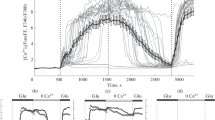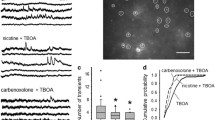In experiments on mice spinal cord slices, it was found that intense apoptosis of motoneurons develops in these slices rather rapidly (6 hours). This process can be significantly suppressed by treatment with the NMDA glutamate receptor antagonist MK-801 (50 μM) and AMPA/kainite non-NMDA glutamate receptor antagonist CNQX (100 μM). Such treatment considerably increased the percentage of viable motoneurons in the ventral horns of the spinal cord. The results obtained confirm the statement that glutamate excitotoxicity could be a significant possible factor responsible for apoptosis of motoneurons under conditions of spinal cord impairment.
Similar content being viewed by others
References
M. S. Beattie, S. L. Shuman, and J. C. Bresnahan, “Apoptosis and spinal cord injury,” Neuroscientist, 4, 163–171 (1998).
H. Chi H, H.-Y- Chang, and T.-K. Sang, “Neuronal cell death mechanisms in major neurodegenerative diseases,” Int. J. Mol. Sci., 19, No. 10, 3082 (2018).
M. J. Crowe, J. C. Bresnahan, S. L. Shuman, et al., “Apoptosis and delayed degeneration after spinal cord injury in rats and monkeys,” Nat. Med., 3, No. 1, 73–76 (1997).
S. Casha, W. R. Yu, and M. G. Fehlings, “FAS deficiency reduces apoptosis, spares axons and improves function after spinal cord injury,” Exp. Neurol., 196, No. 2, 390–400 (2005).
H. R. Momeni and M. Kanje, “Calpain inhibitors delay injury-induced apoptosis in adult mouse spinal cord motor neurons,” Neuroreport, 17, No. 8, 761–765 (2006).
H. R. Momeni, S. Azadi, and M. Kanje, “Calpain activation and apoptosis in motor neurons of cultured adult mouse spinal cord,” Funct. Neurol., 22, No. 2, 105–110 (2007).
F. M. Maynard, “Immobilization hypercalcemia following spinal cord injury,” Arch. Phys. Med. Rehabil., 67, 41–44 (1986).
I. Bezprozvanny, “Calcium signaling and neurodegenerative diseases,” Trends Mol. Med., 15, No. 3, 89–100 (2009).
H. R. Momeni and M. Jarahzadeh, “Effects of a voltage sensitive calcium channel blocker and a sodium-calcium exchanger inhibitor on apoptosis of motor neurons in adult spinal cord slices,” Cell J. (Yakhteh), 14, No. 3, 171–176 (2012).
S. F. Traynelis, L. P. Wollmuth, C. J. McBain, et al., “Glutamate receptor ion channels: Structure, regulation, and function,” Pharmacol. Rev., 62, No. 3, 405–496 (2010).
G. Akgül and C. J. McBain, “Diverse roles for ionotropic glutamate receptors on inhibitory interneurons in developing and adult brain,” J. Physiol., 594, No. 19, 5471–5490 (2016).
X.-x. Dong, Y. Wang, and Z.-h. Qin, “Molecular mechanisms of excitotoxicity and their relevance to pathogenesis of neurodegenerative diseases,” Acta Pharmacol. Sin., 30, No. 4, 379–387 (2009).
C. Matute, E. Alberdi, G. Ibarretxe, and M. V. Sánchez-Gómez, “Excitotoxicity in glial cells,” Eur. J. Pharmacol., 447, No. 2–3, 239–246 (2002).
G. Yu, F. Wu, and E.-S. Wang, “BQ-869, a novel NMDA receptor antagonist, protects against excitotoxicity and attenuates cerebral ischemic injury in stroke,” Int. J. Clin. Exp. Pathol., 8, No. 2, 1213–1225 (2015).
J. L. Cross, B. P. Meloni, A. J. Bakker, et al., “Modes of neuronal calcium entry and homeostasis following cerebral ischemia,” Stroke Res. Treat., 2010, 316862 (2010).
M. G. Van Westerlaak, E. A. Joosten, A. A. Gribnau, et al., “Differential cortico-motoneuron vulnerability after chronic mitochondrial inhibition in vitro and the role of glutamate receptors,” Brain Res.,;922, No. 2, 243–249 (2001).
A. V. Krassioukov, A. Ackery, G. Schwartz, et al., “An in vitro model of neurotrauma in organotypic spinal cord cultures from adult mice,” Brain Res. Brain Res. Protoc., 10, No. 2, 60–68 (2002).
C. A. Connelly, L. C. Chen, and S. D. Colquhoun, “Metabolic activity of cultured rat brainstem, hippocampal and spinal cord slices,”. J. Neurosci. Methods, 99, Nos. 1–2, 1–7 (2000).
J. M. Mouveroux E. A. Lakke, and E. Marani, “Lumbar spinal cord explants from neonatal rat display age-related decrease of outgrowth in culture,” Neurosci. Lett., 311, 69–72 (2001).
A. J. Bruce, B. Malfroy, and M. Baudry, “Beta-amyloid toxicity in organotypic hippocampal cultures: Protection by EUK-8, a synthetic catalytic free radical scavenger,” Proc. Natl. Acad. Sci., 93, No. 6, 2312–2316 (1996).
T. Mosmann, “Rapid colorimetric assay for cellular growth and survival: Application to proliferation and cytotoxicity assays,” J. Immunol. Methods, 65, Nos. 1–2, 55–63 (1983).
S. Elmore, “Apoptosis: A review of programmed cell death,” Toxicol. Pathol., 35, No. 4, 495–516 (2007).
H. R. Momeni and M. Kanje, “The calpain inhibitor VI prevents apoptosis of adult motor neurons,” Neuroreport, 16, No. 10, 1065–1068 (2005).
T. W. Lai, S. Zhang, and Y. T. Wang, “Excitotoxicity and stroke: Identifying novel targets for neuroprotection,” Prog. Neurobiol., 115, 157–188 (2014).
M. K. Kutzing, V. Luo, and B. L. Firestein, “Protection from glutamate-induced excitotoxicity by memantine,” Ann. Biomed. Eng., 40, No. 5, 1170–1181 (2012).
E. A. Sribnick, A. M. Del Re, S. K. Ray, et al., “Estrogen attenuates glutamate-induced cell death by inhibiting Ca2+ influx through L-type voltage-gated Ca2+ channels,” Brain Res., 1276, 159–170 (2009).
G. Vallazza-Deschamps, C. Fuchs, D. Cia, et al., “Diltiazem-induced neuroprotection in glutamate excitotoxicity and ischemic insult of retinal neurons,” Doc. Ophthalmol., 110, No. 1, 25–35 (2005).
H. R. Momeni, “Role of calpain in apoptosis,” Cell J. (Yakhteh), 13, No. 2, 65–72 (2011).
J. M. Wingrave, K. E. Schaecher, E. A. Sribnick, et al., “Early induction of secondary injury factors causing activation of calpain and mitochondria-mediated neuronal apoptosis following spinal cord injury in rats,” J. Neurosci. Res., 73, No. 1, 95–104 (2003).
K. Ajiro, C. D. Bortner, J. Westmoreland, and J. A. Cidlowski, “An endogenous calcium-dependent, caspase-independent intranuclear degradation pathway in thymocyte nuclei: Antagonism by physiological concentrations of K+ ions,” Exp. Cell Res., 314, No. 6, 1237–1249 (2008).
A. G. Yakovlev, G. Wang, B. A. Stoica, et al., “A role of the Ca2+/Mg2+-dependent endonuclease in apoptosis and its inhibition by Poly(ADP-ribose) polymerase,” J. Biol. Chem., 275, No. 28, 21302–21308 (2000).
S. S. Smaili, Y.-T. Hsu, A. C. P. Carvalho, et al., “Mitochondria, calcium and pro-apoptotic proteins as mediators in cell death signaling,” Braz. J. Med. Biol. Res., 36, No. 2, 183–190 (2003).
R. J. Gagliardi, “Neuroprotection, excitotoxicicity and NMDA antagonists,” Arq. Neuropsiquiatr., 58, No. 2B, 583–588 (2000).
S.-Y. Jeong and D.-W. Seol, “The role of mitochondria in apoptosis,” BMB Rep., 41, No. 1, 11–22 (2008).
Author information
Authors and Affiliations
Corresponding author
Rights and permissions
About this article
Cite this article
Momeni, H.R., Jarahzadeh, M. & Farjad, E. Glutamate Excitotoxicity; a Possible Mechanism for Apoptosis of Motoneurons in Adult Mouse Spinal Cord Slices. Neurophysiology 52, 408–414 (2020). https://doi.org/10.1007/s11062-021-09898-1
Published:
Issue Date:
DOI: https://doi.org/10.1007/s11062-021-09898-1




